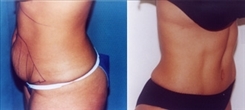Tummy Tuck Recovery
Posted On: June 14, 2018 Author: The Office of Dr. Stuart Linder Posted In: Abdominoplasty, Home, Tummy Tuck
Dr. Linder performs tummy tuck surgery every week in his ambulatory surgery center in Beverly Hills. Tummy tuck surgery should be performed only by board-certified plastic and reconstructive surgeons. These surgeons have the experience, training, and judgment to perform abdominoplasty correctly, as well as to understand the risks and complications and how to correct these should they arise. Our training in general surgery followed by plastic and reconstructive surgery allows us to understand the anatomy of the abdominal wall perfectly.
Complications and Risks
Patients who undergo abdominoplasty or panniculectomy procedures should pre-operatively be instructed on several precautions in order to prevent undue complications and risks. With any surgery, there are risks of bleeding and infection. Bleeding is the most common complication after abdominoplasty. This can be greatly reduced by not exerting increased pressure of the abdominal wall, thereby not straining the rectus sheath muscles, which could lead to suture dehiscence and arterial bleed along the rectus muscle sheath. Patients are instructed not to do any heavy lifting or exertion of the abdominal muscles for six weeks post-operatively. They wear an abdominal binder and are also instructed not to take any platelet-inhibiting products, including aspirin, Motrin, Excedrin, or Ibuprofen.
 Prevention of Infection
Prevention of Infection
Prevention of infection is the second most common problem of all operations, including abdominoplasty. Our patient population is maintained on antibiotics, JP drains are placed and are actively taking fluid out from below the flap, usually between 7 and 10 days. The patients also may not get water on the incision sites until the sutures are finally removed, which may be up to 17 to 21 days. The incision sites are kept dry.
Steri-strips are placed in the operating room and are usually removed on day 7 to 10. The first set of sutures are removed on day 14 with the final set on day 17 to 21. Jackson-Pratt drains are placed in order to reduce seroma formation, a small amount of blood as well as liposuction residual fluid from the tumescent liposuctioning of the iliac crest rolls or hips. Patients are instructed not to return to work until the JP drains are removed. These are not removed until there is at least less than 25 cc per drain, per 24-hour period.
At times one drain may be removed at one week while the second may remain in for a few days longer until again there is less than 25 cc per drain. Sutures are never removed presumptuously. We would rather leave them in longer in the subcuticular fashion than take them out too early, which could cause dehiscence of the incision widespread scarring. Once sutures are removed, and there is no opening of the scab, patients are instructed to start the Bio Corneum or Kelo-Cote silicone gel spray twice a day for the next three to six months, which may help in reduction of telangiectasia, widespread scarring, keloid or hypertrophic scar formation.
Finally, in general, we instruct our patients not to make a final evaluation of the results until at least six months. There is a significant amount of swelling of the abdominal flap, especially the lower abdomen, which can look quite distended and this usually takes at least three months for the swelling to completely resolve. After a six month check, liposuctioning of the lower abdominal flap may be performed in order to smooth it out safely if necessary. Dog-ears may be excised from the hip region. Liposculpturing of the flank region and upper epigastrium can now safely be performed without devascularization of the blood supply to the abdominal flap.